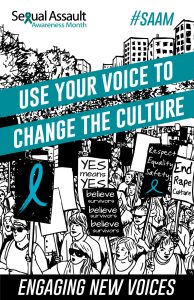by Thea Voutiritsas
In the U.S., April is Sexual Assault Awareness Month (SAAM). Though sexual assault seems like a clear no-no, our culture

enforces social norms that condone violence and negative power relations. Sexual assault is more than a person jumping out of the bushes; its any type of unwanted sexual contact, ranging from sexist attitudes and actions to rape and murder.
Rape and sexual assault are a consequence of the power differential between men and women. Rape doesn’t happen just because one person chooses to rape another. Rape happens because there are attitudes and norms that allow it to happen. We live in a society that normalizes violence, using power over others, traditional constructs of masculinity, the subjugation of women, and silence about violence and abuse. These normalized behaviors are part of rape culture.
Rape culture is about the way we collectively think about rape as a society. Evidence of rape culture can be found in popular music, where “blurred lines” are just part of courtship, and no doesn’t really mean no. It is seen when a woman is blamed for getting drunk, or when a woman is asked “What were you wearing?” We see rape culture when women are told to prevent themselves from being raped, but men are not told not to rape. We see it in jokes that equate raping to winning video games or competitions. We see it when men are told to “wear the pants” in a relationship. We see it when men with multiple partners are “Casanovas,” yet women with multiple partners are “sluts.” We see it in entire categories of porn dedicated to harming or defeating women.
SAAM in April is an opportunity for us to check our thinking patterns. Ask yourself: What do I do, say, allow, or ignore that may contribute to rape culture? And what can I do to change that?